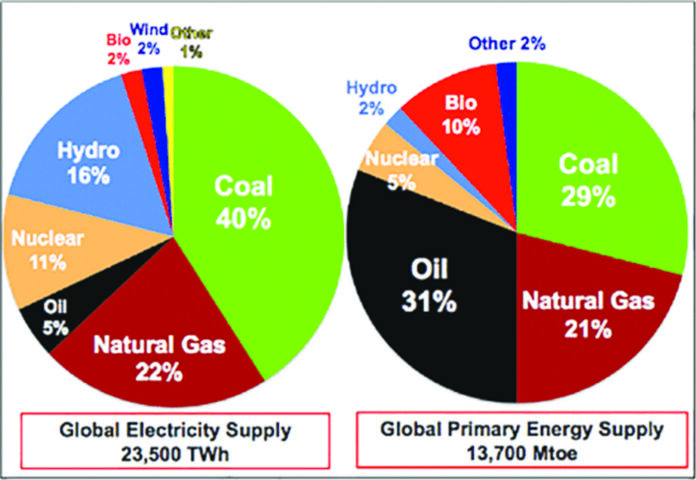The recent global energy supply and demand issue caused by the Russia-Ukraine situation has led to an abrupt shift toward balancing the use of available energy resources. The West has accelerated turning to renewable energy along with non-renewable sources by focusing on diversifying its energy mix. According to an International Energy Agency (IEA) report, the total amount of renewable energy added globally between 2016 and 2021 was 1,282 GW (gigawatts), and this is expected to greatly increase to around 2,400 GW between 2022 and 2027. While proponents of renewable energy are pushing for greener energy sources, states like Germany and Japan are exploring ways to balance their energy mix by utilising cleaner energy sources.
In Pakistan, non-renewable energy accounts for 59 percent of power generation and renewable energy only 2.4 percent; it is critical to focus on diversifying energy sources. While renewable energy is the preferred option, Pakistan can also consider clean energy under both renewable and non-renewable categories by focusing on cost-effective projects utilising hydro, coal, and nuclear resources.
Hydropower is a significant source of clean energy in Pakistan, and its overall contribution to electricity generation has decreased over time. The maintenance and renovation of existing hydropower facilities and infrastructure have become a challenge due to low water levels, lack of grid maintenance facilities, and alternative power reserves. However, Pakistan is working on various macro- and micro-hydropower projects, including the Kohala Hydropower Project (1124MW), the Diamer-Basha Dam (4,500MW capacity), the Duber Khwar Hydropower Project (40MW), the Kurram Tangi Dam Hydropower Project (110MW), and the Golen Gol Hydropower Project (110MW). These initiatives demonstrate Pakistan’s commitment to diversifying its energy mix. Hydel power projects require a sizeable investment and in the case of Pakistan, financial constraints limit the possibility of expansion in hydro. It is nonetheless important to focus on the long-term agenda and incorporate clean energy projects in sources that are widely available within the country.
Coal is considered a low-cost energy source in Pakistan, and coal-based power production has increased over the past five years. In FY16, about 2.2 percent of electricity was generated using coal, which rose to 24 percent in FY21. The Thar coalfield holds the 16th largest coal reserves in the world, with 97 percent of it being lignite, and the remaining 3 percent being classified as bituminous and subbituminous. The National Electric Power Regulatory Authority (NEPRA) is focusing on converting imported coal-based power stations to Thar coal without modifying the plants. The use of coal is hazardous to the environment.
A working paper from the Sustainable Development Policy Institute (SDPI) indicates that the world is moving towards the use of low-emission and higher-efficiency power plants. Countries such as Germany, Poland, and Japan have achieved efficiencies of 40 percent and above in their coal-fired power plants. China has also invested in clean coal technology by implementing the use of supercritical and ultra-supercritical plants that use carbon capture and storage (CCS) technology to decrease emissions from coal-fired power plants.
From a long-term point of view, the government should address issues in the production, transmission, and distribution networks to enhance the efficiency of the grid. The focus should be on reducing energy imports and prioritising domestic energy resources like solar, hydel, coal and nuclear in order to produce clean energy.
The ThalNova Thar Power Plant is a 330 MW coal-fired power project that is based on Thar coal and is part of the China-Pakistan Economic Corridor (CPEC) initiative. The government needs to ensure that China builds and operates these coal power plants using the same technology and efficiency standards. Dr. Samar Mobarakmand, a scientist and head of the Thar Coal Power Project, has focused on plans for a power generation project through gasification aimed at cutting down on negative environmental impact.
Coal gasification takes coal and turns it into something similar to natural gas. It is considered cleaner than coal because part of the process— called Integrated Gasification Combined Cycle, or IGCC— removes some of the pollutants that make coal a public health hazard. In order to mitigate environmental hazards, the government should also focus on reducing emissions from the three major industries that contribute to CO2 emissions— specifically cement (49 percent), power (28 percent), and brick kilns (22 percent).
Pakistan is also currently utilising nuclear power as part of its energy policy, but it only accounts for a mere eight percent of the country’s overall power generation. The government is implementing plans to establish nuclear energy plants as clean energy projects that comply with IAEA regulations. Similar to Japan and Germany, Pakistan is also exploring ways to prevent energy shortages by restarting initiatives for nuclear energy as a clean source. By investing in research and development for small modular reactors, thorium-based reactors, and fast-breeder reactors, Pakistan has the potential to generate more efficient and less wasteful nuclear energy. However, it requires international assistance to gain access to advanced technologies and fully tap the potential of clean nuclear energy.
In the short term, with LNG not an accessible option due to massive European demand, nor expensive fuel imports due to depleting foreign reserves and a chronic circular payment issue, it is prudent to encourage and push non-industrial sectors like agriculture, offices, and residential units toward renewable energy sources— ideally solar installations.
In the immediate and short-term, utilising easily accessible indigenous energy sources like coal while adhering to strict emissions standards could offer stability for a while. Even Germany has resorted to firing up coal power plants as a response to sharp rises in energy prices.
From a long-term point of view, the government should address issues in the production, transmission, and distribution networks to enhance the efficiency of the grid. The focus should be on reducing energy imports and prioritising domestic energy resources like solar, hydel, coal and nuclear in order to produce clean energy.























